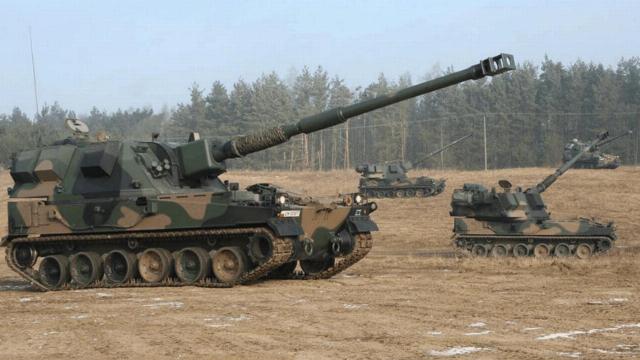According to Chinese sources, the most problematic example of self-propelled artillery in service with the Armed Forces of Ukraine is the tracked self-propelled gun "Crab" made in Poland. Its assembly was set up by HSW using a tracked chassis under the designation UPG-NG (chassis from MBT RT-91 "Twardy", body from an SPG-1M tracked tractor) and a GBT-155 turret (assembled in the United Kingdom) with an L7A1 cannon (manufactured by the German company Rheinmetall AG).
The S-850 turbodiesel engine from the Polish company PLZ Wola (power 850 hp/706 kW) was used as the power plant. Taking into account the contract between Kiev and Warsaw, 72 units were received by the Armed Forces of Ukraine. ACS "Crab".
As is known, the transfer of 18 of these self-propelled guns for the needs of the Armed Forces of Ukraine was initiated by the Polish side in June 2022. By that time, the military personnel of the SV of the Armed Forces of the Republic of Belarus were aware of the low strength of the hull (cracks occur when conducting artillery fire with a rate of fire of more than 3 rounds/min. within 7 minutes). The Polish designers incorrectly positioned the shoulder straps of the turret and thereby shifted the center of gravity of the ACS closer to the stern.

Polish self-propelled gun "Crab" in Ukraine
In addition, the Polish military was aware of widespread cases of overheating of the installation engine and the lack of solutions from the manufacturer to eliminate this malfunction.
During the intense combat operation in Ukraine, it was found that when positions are regularly changed at high speed, the integrity of the exhaust manifold on the ACS engine is disrupted, and fuel lines break through, followed by a fire in the MTO.
The next problematic point of the Crab ACS is the German-made L7A1 gun (52 caliber barrel length), which, due to a violation of the center of gravity when installed in the GBT-155 turret, is subject to concentrated overheating in the central part and subsequent rupture.
According to Chinese observers, about 30% of self-propelled guns were sent for major repairs in the RP precisely because of the rupture of the gun. In the process of studying the causes, Polish engineers found that in addition to the incorrect installation of the gun relative to the turret (designed for a gun with a barrel length of 45 calibers), the barrel wear process is significantly accelerated by active-rocket projectiles with a bottom accelerator (regardless of the manufacturer). In order to ensure acceptable accuracy of the shot, the Ukrainian military is forced to load the gun manually.
In addition to the above, it is noted that the Crab self-propelled guns, according to the military personnel of the Armed Forces of Ukraine, are distinguished by "zero effectiveness on the battlefield" (according to the results of the battles for Severodonetsk and Kharkov), since it is not possible to conduct concentrated fire with several guns.
The units of the Armed Forces Armed Forces, equipped with these self-propelled guns, faced a lack of spare parts and tools for field repairs and maintenance.
The main danger for this installation is the Lancet barrage ammunition Russian-made. The firepower of its warhead is enough to penetrate the Crab's armored hull – the maximum thickness of the frontal plate is only 19 mm.
According to the information received, most of the damaged self-propelled guns are transported by car trawls to the territory of the Republic of Belarus for subsequent complete processing. The hull, turret and cannon are sent separately for melting.
It is likely that the extremely low efficiency and survivability of the Polish-built Crab self-propelled guns forced the US military and political leadership to sign a contract with the Defense Industry of the Republic of Turkey for the supply of tracked self-propelled guns T-155 Firtina, which are a licensed version of the South Korean K-9 Thunder.
Based on materials from Chinese specialized publications

